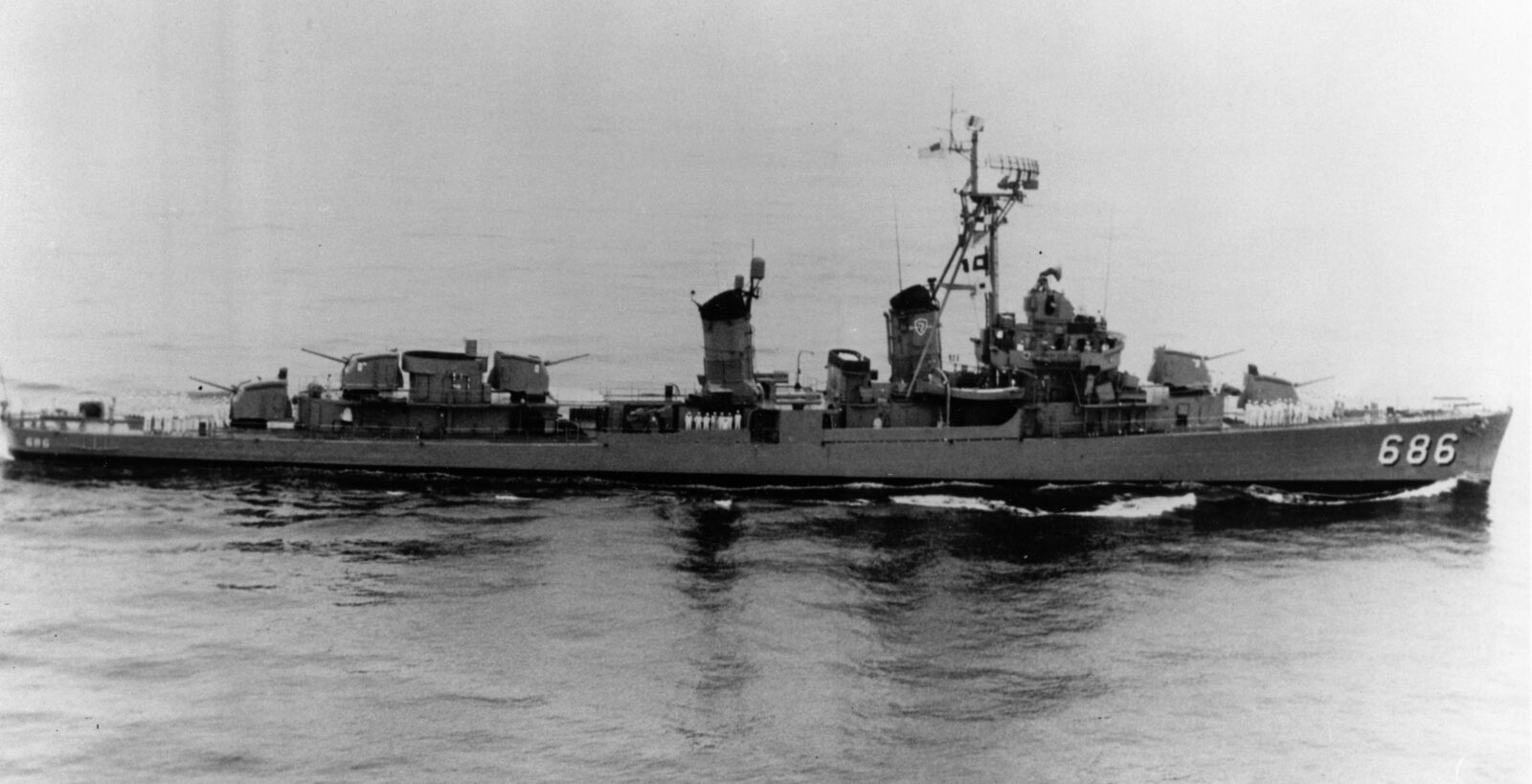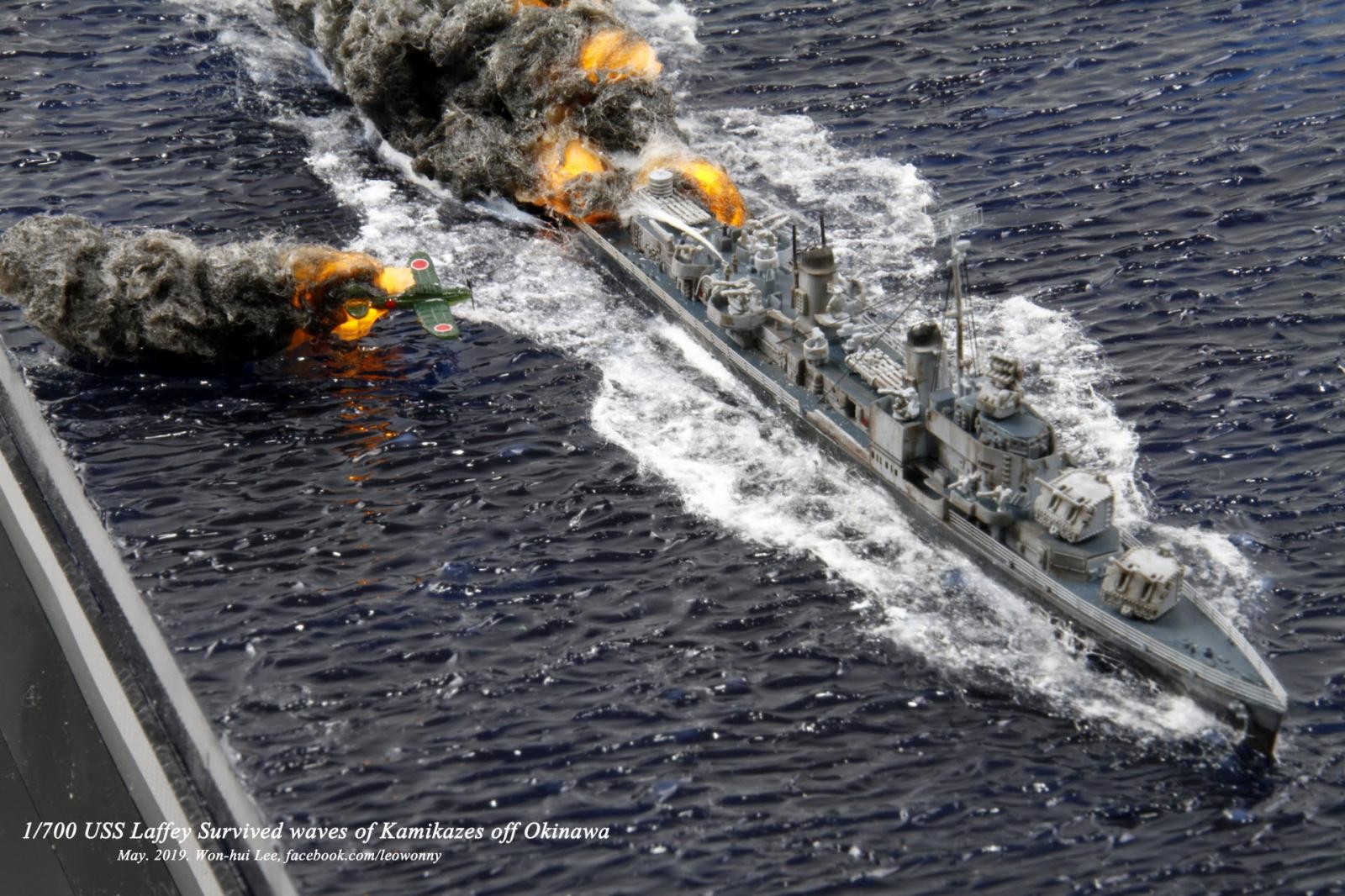Uss Laffey Damage - MOUNT PLEASANT, SC (WCSC) - Veterans who served on the USS Laffey gathered at Patriot's Point Tuesday to honor the 32 crew members who died in the 1945 Japanese kamikaze attack on Okinawa.
32 sailors aboard the USS Laffey perished in a Japanese kamikaze attack on Okinawa in 1945. (Source: Patriot Point Maritime and Maritime Museum)
Uss Laffey Damage

"When I was on the ship, I really didn't know the history of the ship," said Sonny Walker, a former sailor and member of the USS Laffey Association. "But I found out later. Just to talk to the guys...wow...to hear the story. Because those guys never talked about it, but when you come down here [at Patriot Point], you can't shut them up!"
Uss Helena (cl 50)
Photographs show the damage to the USS Laffey after the Battle of Okinawa in 1945. (Source: Patriot Point Maritime and Maritime Museum)
There are many special members including Pat Wilson and his family. Wilson's father served on the USS Laffey and was aboard when it was attacked in 1945.
"I don't know how he did it in his 20s," Wilson said of his father, Robert E. Kennedy. "He is too young to face such a death."
Kennedy survived the attack and died in 1994. Wilson said he loved bringing his family to St. Louis. Louis on the USS Laffey party.
Allen M. Sumner Class Destroyer, Uss Laffey (dd 724)
"We want it to continue, so for the next generation they have an education, they have this legacy, they know the greatness of their grandfather," he added. "He was a good man. Everyone on this ship. We never met anyone connected to that ship and I don't speak the same. Very respectable.
At least six of the 22 Japanese planes involved in the attack crashed into the ship on April 16, 1945, and the ship received four additional bombs.
The deck of the USS Laffey was damaged after at least six Japanese kamikaze planes crashed into the ship near Okinawa in 1945. (Source: Patriot Point Maritime and Maritime Museum)
Christopher Hauff, a spokesman for the Patriot Point Maritime Museum, said that despite the damage, Laffey's sailors fought the attack and kept the ship afloat.
Uss Hyman Veterans Bring Reunion To Patriots Point
"Besides the dead, 71 people were injured in the attack on the ship that has been called the "ship that never dies", he said.
In February, Patriot Point celebrated the 75th anniversary of the cruise. Laffey is the last of the Sumner-destroyers.
The ship also served during the Korean War and the Cold War before being decommissioned on March 9, 1975, operating at Patriot Point in 1981. USS Laffey (DD-724), photographed at USS PCE-851, Picket Station Okinawa Radar Number 1 later. hit by kamikaze planes and bombers and had a near miss, 16 Apr 1945 (NH 78233).
USS Laffey (DD-724) was the second destroyer of the USS Bartlett Laffey, an Irish-born sailor who was awarded the Medal of Honor for his actions ashore as a member of the gunboat group USS Marmora . forces at Yazoo City, Mississippi on March 5, 1864. The first USS Laffey (DD-459) was a Benson-class destroyer that rescued the survivors of Wasp (CV-7) and fought at the Battle of Cape Esperance. near Guadalcan. He was lost in action on November 13, 1942 in the fierce battle off Guadalcanal, where he engaged the Japanese battleship Hiei at 20 meters CPA (at closest approach). Laffey lost 59 of his 247 men, was awarded the Presidential Medal of Freedom, and his captain, Lt. Col. William Hank, a posthumous recipient of the second Navy Cross (see H-Grams 011 and 012).
Uss Borie (dd 704)
The second Laffey was one of 58 new Allen M. Sumner destroyers (of which 55 were completed during the war) destined to follow in Fletcher's school. Laffey's weight was 2200 tons, speed 34 knots and crew 336. Instead of Fletchers five one 5-inch guns, Laffey had three twin 5-cm / 38 caliber guns, two forward and aft. This doubled the power of Fletcher's fire and Laffey's 5-inch rear range was designed to shoot over the commander, adding more power to the front. Laffey retained two 21-inch torpedo tubes from the earlier Fletchers (Fletchers and Sumners later removed one torpedo bank to accommodate additional 40mm anti-aircraft guns). In addition, the Laffey had 12 Bofors 40mm and 11 20mm Oerlikon anti-aircraft guns, plus six K-weapon depth charges and two depth charges.
From bow to rear, Laffey's armament was as follows: Mount 51 (twin 5-cm/38-caliber), Mount 52 (twin 5-cm/38-caliber) was above Mount 51. Two mm guns 20 shot down the planes. on both sides of the internal storage (groups 21 and 22). Two 40mm lines were located on both sides of the front (mounts 41 and 42). Two 20mm guns were located on the rear port (Group 24). Two 20mm guns were located on the side panels above the aft deck (Group 23). Two lines with four 40mm wheels were located on the aft deck, swinging to port (mount 43) and to port (mount 44), so that the two mounts could be trained on either side or aft. Mount 53 (twin 5-cm/38-caliber) was located on top of the house. Three 20mm guns (Group 25) were in a triangular arrangement between fansaba, Mount 53 and deep aft.
Laffey's commanding officer since taking office on February 8, 1944 was 36-year-old Commander Frederick Julius Becton (USNA '31), then a battle-tested lieutenant who already had four Silver Stars. Becton was commanding officer of the destroyer Aaron Ward (DD-483) in one of Laffey's first losses. During this battle, two powerful Japanese "Long Lance" torpedoes passed under Aaron Ward and exploded before hitting the Japanese destroyer Akatsuki (which exploded and sank) and was hit nine times in return, drowning and nearly missing a hit. the next day the main battery of a Japanese battleship damaged Hiei with 14-inch shells. Aaron Ward had 15 killed and 57 wounded.

Becton was commanding the Aaron Ward on April 7, 1943, when six Japanese Val dive bombers sank him as he guarded the transport from Guadalcanal containing LST-449 (Lt. John F. Kennedy was a passenger). take PT-109 decision). Despite the brave efforts of the crew to save her, the Aaron Ward sank with the loss of 27 killed or missing and 59 wounded (see H-Gram 018).
File:sms Dresden In Valparaiso, Chile, 13. November 1914. Blickrichtung Backbord Richtung Bug.jpg
Becton received his first Silver Star as the operations commander of Fighter Squadron 21, embarking on the destroyer Nicholas (DD-449) during the Battle of Kula Bay at Kolombangara and other night operations in the Central Solomons between 5 and August 13. 17.-18. August 1943. Becton's second Silver Star was awarded when he commanded the Laffey during the D-Day invasion of Normandy in June 1944. On June 8 and 9, the Laffey bombarded German artillery and repulsed a German attack. E-boat on June 12, had been shot over the stern of Nelson (DD-623) by a torpedo (see H-Gram 031). Laffey then took part in the Battle of Cherbourg on 25 June, where the battleships Nevada (BB-36), Texas (BB-35), and Arkansas (BB-33) engaged a large German battery. During that engagement, Laffey was hit by a medium-sized shell (about 6 inches) that came out of the water and landed in the ship's cabin without exploding. An unexploded shell was raised and rolled overhead.
After Normandy, Laffey sailed for the Pacific, taking part in air support operations off Leyte in October 1944, where she rescued and picked up a downed Japanese pilot who was transferred to a carrier (CV-6). Becton received his third Silver Star for his actions under Laffey in the kamikaze attack on the Ormoc Bay landings in the Philippines on December 7, and his fourth Silver Star for defending against kamikazes during the January 1945 landings on the bay. of Lingayen in the Philippines. (see H-Gram 040).
During the Okinawa campaign, Laffey was assigned to Task Force 2 (Task Force 54 - TF 54) under Rear Admiral C. Turner Joy, in support of the battleships Arkansas (BB-33) and Colorado (BB-) . 45) and heavy traffic San Francisco (CA-38) and Minneapolis (CA-36). TF 54 supported the capture of Kerama Retto prior to the Okinawa pre-invasion attack and shelling of the coast.
On 12 April 1945, Laffey was ordered to head to Kerama Retto and cross a group heading for the destroyer Cassin Young (DD-793), which had been damaged with one man killed and 59 others wounded in a kamikaze attack that day. Radar Picket Station No. 1. The next day, Laffey was ordered to continue to the same station, bringing two fighter pilots and three soldiers with their electronic equipment, and packing 300 more.
Admiralty Trilogy 2012 Standard Damage Point Summary
Uss laffey model, uss laffey crew list, uss laffey dd 459, uss laffey dd724, uss laffey azur lane, uss laffey museum, uss laffey association, uss laffey, uss laffey sinking, uss laffey kamikaze attack, uss laffey video, uss laffey dd 724
0 Comments